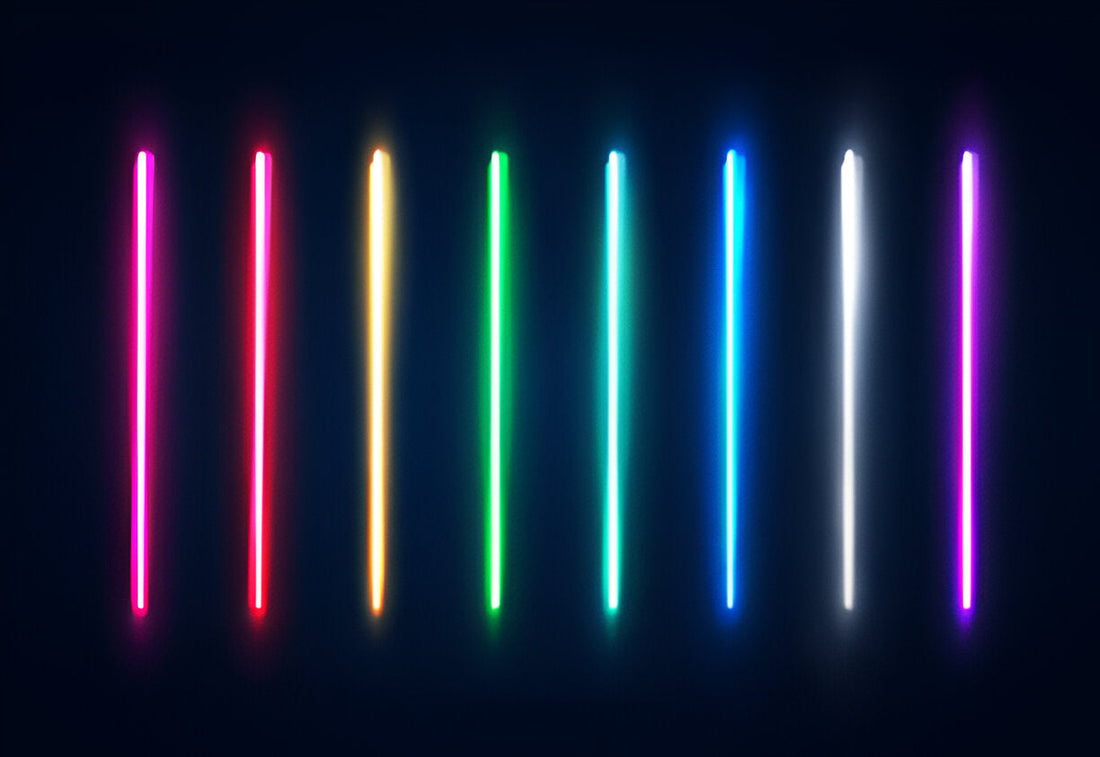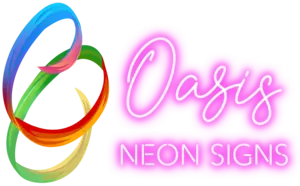
Is Neon a Halogen Light? A Deep Dive into the Glow
Share
It’s not surprising to hear those unfamiliar with the science behind neon lights, asking questions like “Is neon a halogen?” Even if you’re a neon light guru, there’s a chance you’ve also pondered about this unmistakable glow. Well, for most people, the terms “neon” and “halogen” appear interchangeable. But are they really?
In this detailed post, we unravel the mystery that lies behind the science of neon lights and answer queries such as Is neon a halogen or noble gas?
Is Neon a Halogen Light? The Basics of Neon and Halogen
First, it’s better to clarify things with some basic definitions of the two important terms.
What Are Neon Lights?
Neon light is a type of brilliance discharged from a noble gas when subjected to high voltage. They get this fancy name from the noble gas neon, which when burned, produces an iconic red-orange glow. But don’t be fooled by the term “neon”— a good number of the colors or hues you see on neon signs aren’t produced using neon gas. Instead, they’re produced through other gases such as krypton, xenon, and argon.
When the low-pressure neon gas placed in a glass tube is electrified with a high voltage current, it creates reactive luminance which causes the gas to produce a bright light. This light’s unique appearance makes it popular in neon signs for interior decorations, advertising, light art, and more.

What Are Halogen Lights?
Halogen lights are a glow produced by a type of incandescent lamp that contains tungsten filament (just like the old-school light bulbs). They are filled with a small amount of halogen gas, mostly bromine or iodine. This gas helps the filament burn brighter for longer, the reason why they’re commonly used in car headlights and stage lighting.
Halogen lights are not energy efficient due to the excess heat they produce compared to neon lights. This causes incandescent lamps to have a shorter lifespan.
Now, back to the big question: Is neon a halogen light? From the definitions we’ve just given above, the short answer is no, it is not. Neon and halogen lights operate on totally different principles, rely on different types of gases, and serve different purposes.

Breaking Down the Glow: How Neon Lights Work
After distinguishing halogen light from neon light, let’s dig a little deeper into how neon signs work. Every neon light features a tightly sealed glass tube filled with one of the noble gases we mentioned earlier. When you apply high voltage electric current to the gas, the atoms get excited causing them to glow brilliantly. The color of the light depends on the type of noble gas used.
Pure neon gas will always emit a red-orange glow. When most people talk of the classic “neon” color, this is often what they mean. But as you’re aware, the traditional neon light and sign is not limited to only red-orange glow. To achieve a wider spectrum, other types of noble gases are used. For instance, argon gives off a pale lavender glow. When enhanced with a little bit of mercury, it becomes bright blue. Krypton, on the other hand, gives off a white glow while xenon glows bluish-white. In other instances, the inner part of the glass tube has phosphor coatings to achieve different hues when light is emitted. This is how hues like yellow, pink, and green are achieved.
What makes neon lights beautiful is their simplicity and the magical way they breathe life into gas, achieving vibrant, striking glows that are now a part of the modern lifestyle.
Halogen Lights: A Different Kind of Brilliance
From answering the question Is neon a halogen, we’ve noted that neon lights need a noble gas and electricity to work. Halogen lights, on the other hand, rely on tungsten filament, halogen gas, and electricity to function.
The main difference is the type of gas that both neon and halogen lights use. In the case of the latter, the gas reacts with the tungsten vapor when the filament becomes hot. This redeposits the tungsten onto the filament, enabling it to burn with high brilliance and last longer than an ordinary incandescent bulb.

What Causes the Neon vs Halogen Light Confusion?
So, what causes the confusion between neon and halogen lights? What confuses most people is the fact that they both use electricity and gas to produce light. But if you break down into the basics of each, the difference becomes clear like day and night.
Another key difference between these two lights comes from their application. Halogen lights are mainly used for general lighting such as flood lights, car headlights, and desk lamps. Neon lights on the other hand are all about enhancement through vibrant signs and displays.
Why Neon Isn’t a Halogen Light—And Why That’s a Good Thing
Up to this point, we hope everything about the question Is neon a halogen or noble gas is clear. But understanding that neon lights are different from halogen lights goes beyond the technical details. The difference is a key point that explains why neon lights are special in their own way. Neon lights operating on the principle of gas discharge allow them to generate a unique, vibrant glow that makes them a staple in advertising and art.
While the light produced by halogen lamps is incredibly useful, it’s nowhere close to the visual appeal that neon light produces. Halogen lights are undeniably functional, but they don’t have the charm and character that neon lights have to offer.
So, while a neon light wouldn’t offer the best illumination for your workspace, you certainly wouldn’t use a halogen light to achieve that Instagram-worthy backdrop for special events like weddings. Neon lights are special and this explains why they have taken over in decorations, turning ordinary spaces into jaw-dropping modern decors.
Introducing LED Neon: The Modern Twist on a Classic Glow
Since the first commercial use of neon sign in 1910 at a Parisian motor show, traditional neon lights have been enchanting the world with their glow for over a century. But now, there’s a new, more efficient player in town – LED neon. You’ve most likely seen them and interacted with them, whether in sleek home décor or trendy storefronts. You probably wonder how they compare to the classic neon signs you know and love.
What Exactly is LED Neon?
LED neon light is a contemporary version of the traditional neon light sign that uses light-emitting diode (LED) technology to achieve the same brilliance and appearance of the class neon lighting. Instead of using gas-filled glass tubes, these modern LED neon signs rely on flexible, durable LED strips with polymer encasing. While this design doesn’t offer the exact look and feel of traditional neon lights, it comes with so many advantages that make it a preferred choice in modern décor.
Energy efficiency: While the classic neon light uses less energy than a halogen light, LED neon consumes significantly less power than the former. This makes it environmentally safe and a cost-effective option.
Durability: The LED neon signs come with solid construction featuring polymer casing, making them more resistant to damage. Unlike traditional neon signs that use glass tubes, they’re less fragile and therefore ideal for both outdoor use and high-traffic areas.
Customization: There’s almost no design you can’t achieve with an LED neon sign. The strips can easily bend to form intricate patterns and shapes, which is very important to showcase creativity. Traditional glass tube neon signs are labor-demanding and it's extremely difficult to implement complex designs.
Installation and maintenance: LED neon signs are much easier to install and maintain. Since they’re incredibly lightweight and consume less electricity, you don’t need expertise or specialized tools to install them. Like our collections of neon signs from Oasis Neon Signs, they feature a plug-and-play design.
Even though purists might argue that traditional neon signs offer a nostalgic glow, LED neon signs can mimic the same inviting appeal. Plus, they do this with the added advantage of modern versatility. Whatever your décor theme is, LED neon signs make it easy to find the perfect matching color for it.
Ending the Halogen vs Neon Light Debate
For neon sign enthusiasts, understanding whether neon is halogen or not is just a piece of the puzzle. The reason neon lights are truly fascinating is that they perfectly blend science with art. From the glass tube design and choice of noble gas to the electrical engineering behind them, neon signs offer the perfect fusion of form and function.
By now, you understand that halogen lights and neon lights are two completely different things. While halogen lights use a tungsten filament and halogen gas (bromine or iodine) to produce bright light, neon lights use a glass tube filled with neon noble gas and high-voltage electricity to produce a vibrant glow. This makes neon lights superior when it comes to transforming the appeal of a space through a nostalgic look and feel.
The shallow dive into LED neon lights revealed to you that while halogen lights and neon lights are different, there’s an even better alternative when it comes to space decorations. If you’re just getting started with neon signs, an LED neon sign offers an excellent way to experience this luminous art form minus the worries of fragility, energy inefficiency, and maintenance.
Wrapping Up
So, is neon a halogen light? No, it’s not. Neon lights and halogen lights are completely different, each with unique features and use. Halogen lamps often produce stronger light and are best for practical illumination. Neon lights, on the other hand, focus on the art of the glow and are a perfect blend of creativity and science. They bring a rather dull space to life with a wide array of hues and nostalgic glow.
By understanding the science behind halogen and neon lights, you can strengthen your appreciation for these luminous art forms. To transform your space with a modern glow, LED neon lights mimic the glow of classic neon without the downsides of energy inefficiency, fragility, and maintenance. To get you started with LED neon lights, use the free neon sign design tool and Oasis Neon Signs will bring your design idea to life.

